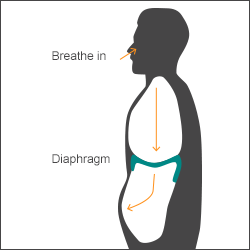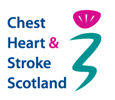Relaxing using diaphragmatic breathing

One reason why people with respiratory illness sometimes feel their breathing is laboured or difficult is that they are breathing with their upper chest and air is not getting in and out of the lungs as deeply as it should.
The diaphragm is the main breathing muscle which is situated below the lungs. As it contracts air is pulled into the lungs and as it relaxes air is pushed out.
The following technique is called diaphragmatic breathing. (Sometimes known as belly breathing)
- Sit comfortably.
- Close your eyes. Focus your attention on your breathing. Do not try to change your breathing for the moment. Become aware of how fast or slow you are breathing.
- Place one hand on your stomach and the other on your chest. As you breathe you should notice the hand on your stomach rise and fall as you breathe in and out. It may not be noticeable at first. The hand on your chest should hardly move.
- Breathe in deeply through the nose and notice that the hand on your stomach rises. Your lungs are filling up with air.
- Breathe out through the mouth with pursed lips (as if you are going to whistle) but just listen to the breath sound. Your stomach will relax and return to its normal position.
- Continue this slow, controlled breathing for a few breaths until you feel your breathing reach a natural rhythm.
- Continue for 5 to 10 minutes.
- Notice how you feel now and how your breathing feels.
The person should practice everyday if possible. It can also help to aid sleep at night.
Don’t force breaths. Breathing too quickly, too deeply or irregularly can result in unpleasant symptoms such as dizziness, faintness, headache, visual disturbance, tingling, chest pain, palpitations, sighing, yawning and excessive sniffing. It can trigger the anxiety the patient is trying to avoid.




